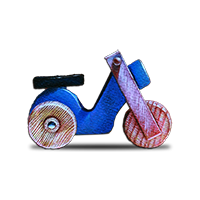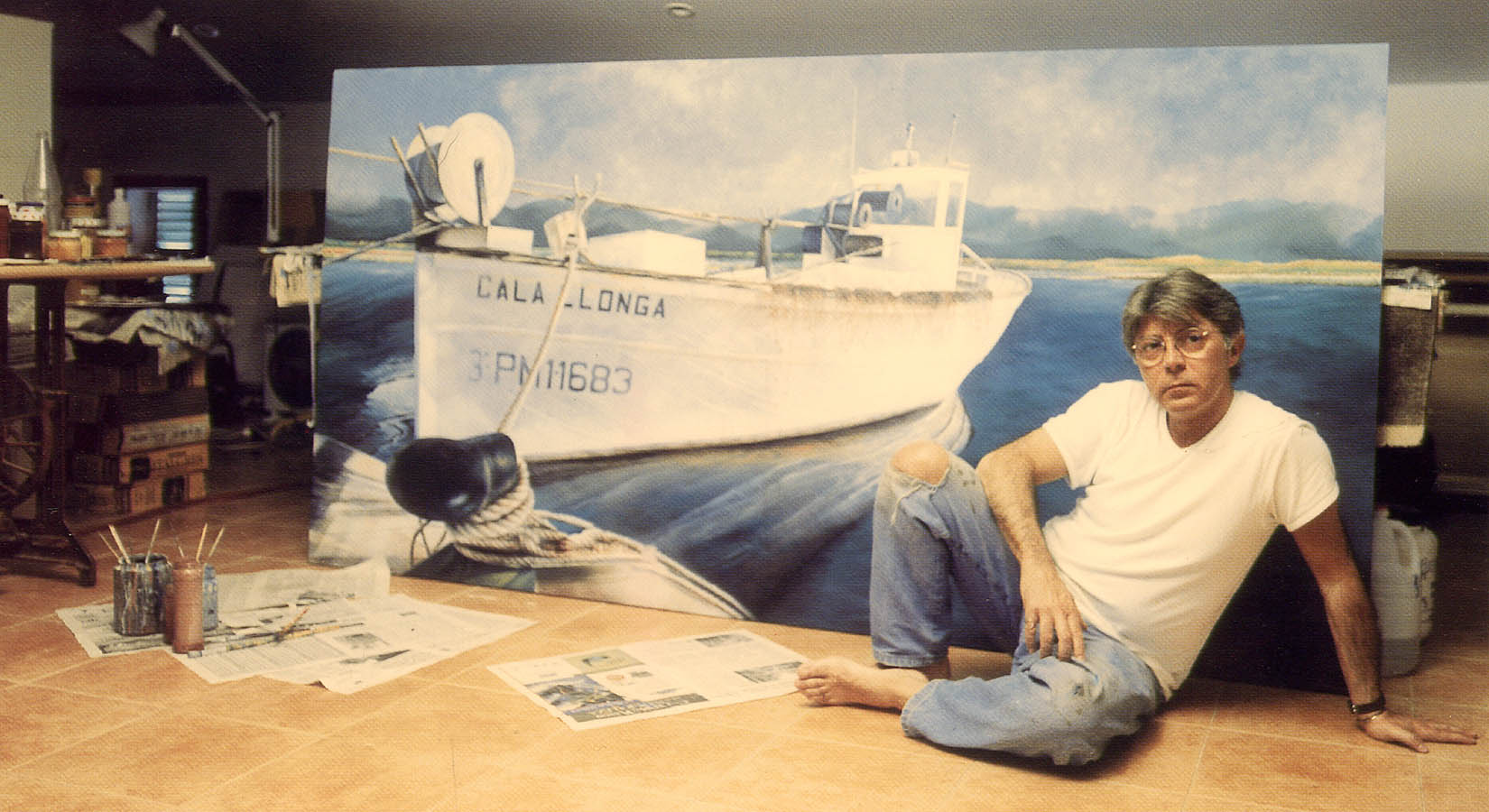
Picture: Sebastià Vidal, Porreres. Estudi carrer Lluís, de Porreres. 2001
Jordi Miralles Hostalot
Since he was a child, his games have always been related to handicrafts and creations.
Observing, trying to retain as many things as possible, in order to be able to visualise them in his mind, are resources and forms of self-discipline, which he would later use to send a blank piece of paper.
At school, at playground time, for most, his game was to play ball, a ball that was new every day because it had paper and plastic bags (from the children’s breakfasts), he didn’t see any sense, and even now, they understand the masses that a ball drags, or something similar.
He would rather sit in a corner and watch. On a sheet of paper, which he would bring down from the classroom and a pencil, he would capture ideas, unidentified shapes, he would make his hand develop, he would film himself. Going for a walk alone, watching the people passing by, the movements, the colours, the net, the silence in the noise of the city.
Drawing has always been a part of him, he liked to watch cartoon films, in fact his father often took him to the Publi cinema on Passeig de Gràcia in Barcelona on Sunday mornings, where at that time they showed the famous Tom and Jerry and Walt Disney films. He saw such perfection in both the lines and the movements that more than once they repeated the session.
The family, of which there were six: grand parents, peers and siblings, although nothing in abundance, always tried to make his life easier, to give him a good education and to pass on their values.
Joan González Torres (Art teacher)

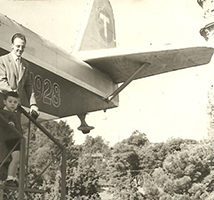
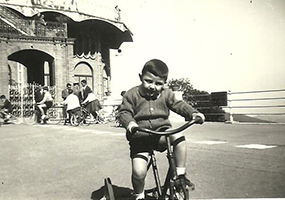
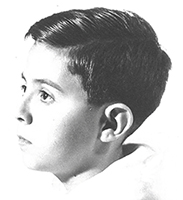
It is clear that many visual stimuli accumulated throughout life contribute to the formation of a painter. We will never know what influence these toys, simple wooden houses that my father, Eduard, gave as a present to Jordi Miralles i Hostalot, now a fully consolidated artist with a hyperrealist style of great impact, had on him.
However, we can be sure that those objects of elementary shapes and colours were as important for his formation as a person and as an artist as the fact that the gift was the expression of affection for the young son and grandson of a friendly family with whom our father shared illusions and aspirations for future generations to achieve a better reality.
All this is confirmation that art does not only express ideas, objects and images, but rather incorporates values and meanings that the more real and profound they are, the more they bring aesthetic pleasure to the public who can enjoy their contemplation. Looking at these paintings, I would be left with equal parts, with the light that reflects in my eyes, as with the intangible tenderness that they express.
Eduard Amouroux Alemany
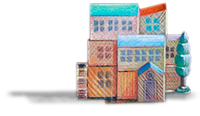

Exhibitions
1985
Nadal Art Gallery, Palma de Mallorca
New Gallery, Sitges (Barcelona).
Subex Gallery, Barcelona.
1993
Sant Jordi Gallery, Matadepera (Barcelona).
1997
Exhibition hall – Sa Nostra, Llucmajor (Mallorca).
1998
El Corte Inglés, Palma de Mallorca.
Exhibition Hall – La Caixa, Porreres, (Mallorca) – Live demonstration sessions of oil painting with water.
Levante Art Gallery, Sa Coma (Mallorca).
Sa Capella Fonda, María de la Salud (Mallorca).
El Corte Inglés, Palma de Mallorca.
1999
Session Hall, Campos (Mallorca).
Culture Hall, Santa Margalida (Mallorca).
2000
Casal Can Cruz de Inca, Capdepera (Mallorca).
2001
Parish Hall, Son Servera (Mallorca).
Hotel Formentor Gallery, Puerto de Pollensa (Mallorca).
2010
Night fair in the New Church, Son Servera (Mallorca).
s´Escorxador Porreres Building Room (Mallorca).
2011
Joan Mascaró i Fornès Cultural Center, Santa Margalida City Council, (Mallorca).
Subex Art Gallery (Summer Collective), Barcelona.
Social Security Treasury, Palma de Mallorca.
2012
Subex Art Gallery, Barcelona.
Rue Privée Art Gallery, Montpellier (France).
Nova 3 Gallery, Sabadell.
2013
Porreres Fair, La Caixa Gallery, Porreres (Mallorca).
2014
Subex Art Gallery, Barcelona.
2025 Cultural Foundation Coll Bardolet, Valldemossa, Mallorca.
His work is found in:
1985 In the Museum and Art Fund of Porreres (Mallorca).
1987 Altarpiece 100 x 400 cm. Parish of San Pablo, Ibiza.
1995 Altarpiece 300 x 150 cm. Parish of San Ciriaco, Ibiza.
2001 Altarpiece 244 x 122 cm El Centro Restaurant, Porreres (Mallorca).
Most of his works are found in private collections.
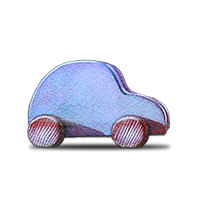
I drew the sea
And when I was closer
Of what she wanted,
It seemed that the silhouette of the mirror
He recognized me.
That sensation
It was repeated in each brushstroke
And the eyes of that face
They are confused with mine.
And it was me who looked,
It was me they were looking at.
The paper was dry land
And my brush, the divining rod.
The rope that unites us,
It parades
And her face blurs.
He felt that thousands of sirens were moving away with him, towards the bottom.
And there I stayed,
in the midst of unpredictable destiny,
a stranger.
Expecting,
………….. expecting.
………….. until the universe of light
It came in like a snap of lightning at the ankles.
I looked at you again,
With the hands, with the feet, with the brain.
Your sap spread through my fingers,
Until the knots of the soul are untied.
My face became outlined in the water.
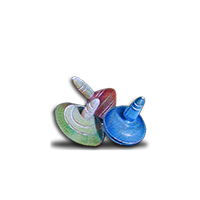
Jordi Miralles’ paint has the property of peeling off the skin. Space than in time. Describe childhood scenes. That hoards Games and Toys. It has the power to enchant you, to open the window that looks inside the blue residence.
He has the virtue of steadfast in the existence of the fragments of him.
Xisco Barceló (Canal 4 TV Balear 2000)
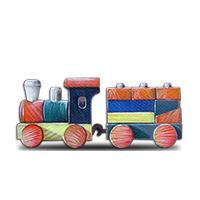
Exaltation of simplicity
Like impetuous thunder in the midst of the storm, like a brilliant lightning bolt that clears up the darkness. In this way, the Catalan artist Jordi Miralles i Hostalot took refuge in our land to enliven his artistic panorama and rejuvenate his pictorial approaches.
Miralles does not appear to us as a conventional painter, but as a singular, vigorous and slightly unorthodox artist. He is not moved by the static beauty of grandiose landscapes or by the mannered and ephemeral interior compositions. Miralles is not enthusiastic about transcendent themes, ostentatious motifs, dazzling objects… He focuses his virtuous skill on other adventures and fixes his gaze on facts, details and things that for others, lacking his sensitivity, remain in the shadows. forgetfulness.
The whole of his work, directed towards the realm of hyperrealism – despite still spilling drips of surrealism – markedly personal and impregnated with a great torrent of honesty, stands out in the exaltation of simplicity, in the dignification of the most natural elements, most common and homemade. The world of seafaring, the realm of humble flora and the dream universe that children invent with toys are some of the most important frames of reference for the Barcelona painter and on which he pours his creativity.
Who might be interested in such prosaic objects as old rope heads for mooring boats, worm-eaten pulleys for hoisting sails, or sanded corks showing fishing nets? Who is the daring one who pays attention to reviving old toys? Who is capable of capturing the attraction that gently malformed lemons give off?
Only an artist wounded by the touch of genius like Jordi Miralles, only a man pushed by the overwhelming task of transcendentalizing the most humble objects.
The influence of the sea is evident in the paintings of ropes intertwined by a thousand knots, in street lamps anchored to poles of llaüts, in rocks kissed by turquoise waters, but also in the pines and bushes of Salobrar de Campos or in the humble and spongy plants that ride the dunes of Es Trenc. Old and collapsed toys revive our childhood and bring us closer to a distant environment full of nostalgia.
The main themes of Miralles’ work – elaborated with a profusion of enriching details – have their genesis in natural notes and, as a result of a process of reflection, are enlarged until they reach the highest levels of magnificence. These basic motifs are set by a chromatic riot of cold tones that confirm the author as a consummate master in mastering the palette.
As a result of his global conception of the pictorial work, “the painting actually encompasses the entire space included between the limits of the frame.”
assures—the relevant motifs share prominence with other resources that, in addition to complementing the meaning of the central elements, expand their symbolic richness and give them a totalizing meaning.
It is through vaporizations, insinuations, intuited brushstrokes and transparencies that Jordi Miralles’ work offers us different readings of essential meanings. And it is through the twists of almost imperceptible details, the meticulous superimposition of planes and the application of barely sketched leaks that the author wants to provoke new sensations in the viewer’s eye. With the use of acrylic technique and pencil, the artist recreates unprecedented visions and magical compositions arising from his inner world, lavish and enchanting.
All these pictorial resources that the artist incorporates into his work to enrich his expressive possibilities exude sensations of calm, atmospheres of warmth and atmospheres of majestic serenity. In addition, there is a chain of pale lines that overlap faint horizons to create textures of delicate presentation.
I have never liked to prophesy, because most of the predictions I have made have turned out to be wrong. Now I want to take risks again, as a game with myself. There will come a day when Jordi Miralles’ work will reach the highest levels of prestige and recognition. And this day will occur when the artistic world fully and conscientiously values a task done with the deep reflection that the head provides and with the measured feeling that the heart distills. A true bet for the future.
Antoni Rosselló i Torres (Diario de Mallorca)
